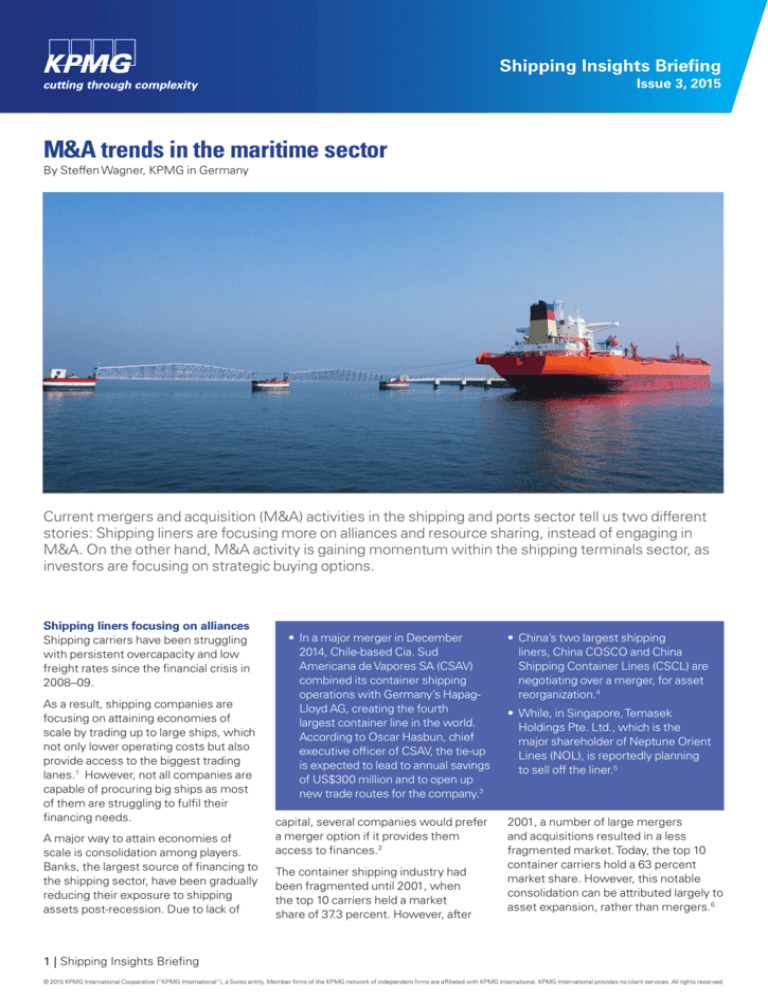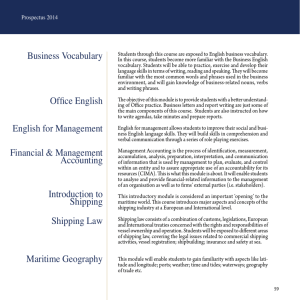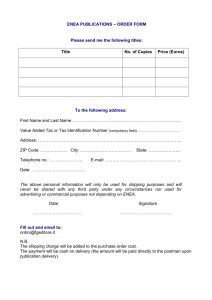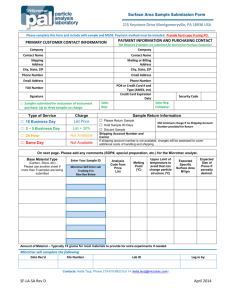
Shipping Insights Briefing
Issue 3, 2015
M&A trends in the maritime sector
By Steffen Wagner, KPMG in Germany
Current mergers and acquisition (M&A) activities in the shipping and ports sector tell us two different
stories: Shipping liners are focusing more on alliances and resource sharing, instead of engaging in
M&A. On the other hand, M&A activity is gaining momentum within the shipping terminals sector, as
investors are focusing on strategic buying options.
Shipping liners focusing on alliances
Shipping carriers have been struggling
with persistent overcapacity and low
freight rates since the financial crisis in
2008–09.
As a result, shipping companies are
focusing on attaining economies of
scale by trading up to large ships, which
not only lower operating costs but also
provide access to the biggest trading
lanes.1 However, not all companies are
capable of procuring big ships as most
of them are struggling to fulfil their
financing needs.
A major way to attain economies of
scale is consolidation among players.
Banks, the largest source of financing to
the shipping sector, have been gradually
reducing their exposure to shipping
assets post-recession. Due to lack of
• In a major merger in December
2014, Chile-based Cia. Sud
Americana de Vapores SA (CSAV)
combined its container shipping
operations with Germany’s HapagLloyd AG, creating the fourth
largest container line in the world.
According to Oscar Hasbun, chief
executive officer of CSAV, the tie-up
is expected to lead to annual savings
of US$300 million and to open up
new trade routes for the company.3
capital, several companies would prefer
a merger option if it provides them
access to finances.2
The container shipping industry had
been fragmented until 2001, when
the top 10 carriers held a market
share of 37.3 percent. However, after
• China’s two largest shipping
liners, China COSCO and China
Shipping Container Lines (CSCL) are
negotiating over a merger, for asset
reorganization.4
• While, in Singapore, Temasek
Holdings Pte. Ltd., which is the
major shareholder of Neptune Orient
Lines (NOL), is reportedly planning
to sell off the liner.5 2001, a number of large mergers
and acquisitions resulted in a less
fragmented market. Today, the top 10
container carriers hold a 63 percent
market share. However, this notable
consolidation can be attributed largely to
asset expansion, rather than mergers.6
1 | Shipping Insights Briefing
© 2015 KPMG International Cooperative (“KPMG International”), a Swiss entity. Member firms of the KPMG network of independent firms are affiliated with KPMG International. KPMG International provides no client services. All rights reserved.
In fact, merger or acquisition among
companies operating over the arterial
trade routes, is few and far between.
Although, consolidation is a viable
option, for gaining financial control,
many factors such as family-owned
interest and state interest, hamper
larger M&A deals.7
Currently, four major alliances dominate
the global shipping industry: 2M, Ocean
Three, G6 and CKYHE group.8 Similar to
code-sharing between airlines, shipping
alliances help in reducing costs and
increasing geographic reach by sharing
ships and port facilities. Although,
demand for alliances is driven by cost
pressure, reluctance to lose control
on the part of firms owned by families
or sovereign wealth funds has further
fuelled the need to form alliances.9
Preference for alliances and an
improved operating margin may
hamper M&A activity
A major trend that has evolved over
the past few years is that an increasing
number of companies have become
interested in creating alliances.
At the same time, creating alliances may
not solve the challenges of overcapacity
or high freight rates. Moreover, the
efficiency of alliances has also become
a matter of concern as complete
cooperation between alliance partners
is yet to be achieved
Low fuel prices have also cushioned
the profitability of shipping liners. Even
as revenue is declining, during H1
2015, carriers have been able to more
than triple their operating margins over
2014 figures, due to rapidly falling fuel
prices. In H1 2015, CMA CGM’s fuel
cost declined 33 percent, compared
with that in H1 2014. Moreover, large
and fuel-efficient ships are also lowering
costs.10 Figure 1 shows the gradual rise
in operating margins of shipping liners.
Figure 1: Quarterly operating margin for shipping liners, Q1 2009 – Q2 2015
20.0%
15.0%
10.0%
5.0%
0.0%
-5.0% 1Q 09
-10.0%
-15.0%
-20.0%
-25.0%
3Q 09
1Q 10
3Q 10
1Q 11
3Q 11
1Q 12
3Q 12
1Q 13
3Q 13
1Q 14
3Q 14
1Q 15
Operating margin
Source: Alphaliner
However, in the long run, the effects of
fuel prices, freight rates and ship sizes
may not always be favorable. Smaller
liners, particularly, will face challenges
in attracting favorable freight rates since
they are in direct competition with big
liners for business. “Continuing low
freight rates will eventually persuade
some, either of their own volition or
coerced by the banks, to find pooling
partners to maximize the potential
of their vessels,” according to Justin
Archard, Managing Director, Asia Pacific
& Oceania at SAL Heavy Lift
Singapore Pte Ltd.11
M&A activity in ports increasing
Investment in the transport sector
has increased significantly, as many
countries are focusing on creating better
and integrated infrastructure. Increasing
the efficiency of ports is particularly
important, as approximately 90 percent
of global trade is conducted via ships.
As shipping companies are focusing
on getting larger ships, demand for
upgraded or new ports is increasing.
Port congestion, due to larger ships and
an increase in shipping alliances, has
become a major issue, and is affecting
terminal businesses particularly in
the US.
As bank financing is limited, particularly
in Europe, terminal operators are
focusing on equity financing options
to expand port infrastructure. These
options include M&A, share issues
and sale of portfolio. Further, terminal
operators are seeking investment from
sovereign funds and governments.12
Figure 2 shows that M&A activity
in shipping terminals, has gradually
increased during 2014–15.
Continuing low freight rates will eventually persuade some,
either of their own volition or coerced by the banks, to find
pooling partners to maximize the potential of their vessels.
Justin Archard, Managing Director, Asia Pacific & Oceania at SAL Heavy Lift
Singapore Pte Ltd
2 | Shipping Insights Briefing
© 2015 KPMG International Cooperative (“KPMG International”), a Swiss entity. Member firms of the KPMG network of independent firms are affiliated with KPMG International. KPMG International provides no client services. All rights reserved.
Figure 2: Shipping terminals, deal values, in US$ billion (as per announcement date)
12
9.7
10
9.9
9.4
US$bn
8
5.6
6
4
4.8
3.0
2.9
2
0
H1
2010
H2
2010
H1
2011
1.3
1.5
H2
2011
H1
2012
H2
2012
H1
2013
H2
2013
3.3
3.2
H1
2014
H2
2014
H1
2015
Source: Thomson One Banker, as on October 19, 2015
Growing South East Asian trade
aiding M&A activity
Low prices and privatization plans in
mature markets
Among the global shipping trade lanes,
South East Asian trade routes have
seen increased trade activities, due to
increased demand. Shipping terminals,
in this region, are facing challenges
of not only accommodating larger
ships, but also extending value-added
services such as providing logistical
support to shipments. This in turn,
is forcing the terminals to explore
options of consolidation. Further,
state investments funds, with access
to capital, are also exploring ways to
expand their reach globally, by acquiring
strategic assets.
M&A activity is increasing not only
in developing economies, but also in
developed economies. In 2014, several
high-profile deals took place in the US,
including the sale of APM Terminals’
Norfolk, Virginia terminal.16 Further,
shipping liners are selling their terminal
assets as they are focusing on reducing
costs by improving their core activities.
• Malaysian port operator Westports
Holdings, which reported net profit
of US$39 million in 2014, is actively
looking for M&A targets in the region.13
• In September 2015, China’s COSCO
teamed up with China Merchants
Group and China Investment Corp
(CIC) to buy a US$950 million stake in
Turkey’s largest private port.
• COSCO is also a front-runner to acquire
a 51 percent stake in Greece’s Piraeus
Port Authority (PPA)14.
M&A activity in China is influenced by
the country’s plans for the Silk Road
Economic Belt, which will link China’s
Yangtze River Delta, Pearl River Delta
and Bohai Sea economic zones with the
European economy.15
“The sector’s strong financial
performance and accelerating growth
is encouraging new market entrants
and renewed merger and acquisition
activity in the container ports sector.
Financial investors are particularly active
at present, attracted by typical EBITDA
margins of between 20% and 45%,”
said Neil Davidson, senior analyst in
Drewry Maritime Research’s ports and
terminals practice.17
The increase in M&A activity is also due
to relatively lower acquisition prices
— about 8–12 times the EBITDA of
companies.
Additionally, the attractiveness of US
terminals have increased mostly due to
terminals’ focus on automation, thereby
reducing labor costs. Thus, US terminals
will be major M&A targets, and the
number of deals in the region might
further increase.
Focus on privatization by some
governments is also leading to an
increase in deal activity among
terminals. While the Greek government
mulled over the privatization of ports and
rail companies, the Russian government
in 2014 approved plans to privatize
more than 400 companies. Among
these companies, the Novorossiysk
Commercial Sea Port, was one of the
valuable assets the state had put up for
sale.18,19
Conclusion
In 2014, listed shipping companies
reported a decline in EV/EBITDA
valuation multiples, making them
accessible targets for acquisition. So
far, alliances, instead of M&A, have
proven to be ideal cost-saving models
for shipping liners. On the other hand,
ocean carriers are selling their terminal
assets; and financial investors, who
invested heavily during the mid2000s, are seeking to exit the market.
Therefore, we believe that M&A activity
in the shipping sector, particularly within
terminals, will increase in the coming
years.
3 | Shipping Insights Briefing
© 2015 KPMG International Cooperative (“KPMG International”), a Swiss entity. Member firms of the KPMG network of independent firms are affiliated with KPMG International. KPMG International provides no client services. All rights reserved.
Source
1
2
3
4
5
6
7
8
9
10
11
12
13
14
15
16
17
18
19
Container Shipping Faces Merger Urge as Money Dries Up: Freight, Bloomberg, January 30, 2013
Container Shipping Faces Merger Urge as Money Dries Up: Freight, Bloomberg, January 30, 2013
CSAV Tie-up With Hapag-Lloyd Approved by Shareholders, Bloomberg, March 21, 2014
COSCO, China shipping talks to drag on for another month, JOC, September 29, 2015
Update: Temasek Looking to Sell Singapore’s NOL For $1.7 Billion, Asia Pacific News, July 20, 2015
The covert consolidation of the container shipping industry, Seanews, July 29, 2013
Alliances not the answer to container shipping’s financial woes, Lloyd’s Loading List, March 10, 2015
Alliances not the answer to container shipping’s financial woes, Lloyd’s Loading List, March 10, 2015
Shipping Alliance Set to Make Waves, WSJ, March 26, 2014
Carriers will struggle to sustain first-half profitability, JOC, September 21, 2015
Shipping industry to see more M&As in 2015, Hellenic Shopping, December 31, 2014
Investing for the future, Port Finance International, Accessed on October 8, 2015
Westports looking for Southeast Asia M&A targets, Seatrade, February 23, 2015
Cosco’s Turkish port foray shakes Greek privatisation plans, Seatrade, September 29, 2015
China port giants pour $1 billion into Turkish terminal, JOC, September 17, 2015
M&A business booms in low-risk US terminals, Port Strategy, August 26, 2014
Investing for the future, Port Finance International, Accessed on October 8, 2015
Greece may freeze privatization plans for rails, airport and Thessaloniki port, JOC, January 29, 2015
Russia to Privatize Additional 431 Companies Through 2016, The Moscow Times, April 1, 2014
Contact us
Dr Steffen Wagner
Global Chair, Transport and Leisure
T: + 49 69 9587 1507
E: steffenwagner@kpmg.com
Hartmut Heckert
Global Head of Shipping
T: + 49 40 32015 5307
E: hhackert@kpmg.com
Join us at the Global Shipping Conference to discuss the future of shipping
GLOBAL SHIPPING CONFERENCE 2015
navigating the future
3 November 2015, Hamburg
www.kpmg.com/GSC2015
kpmg.com
The information contained herein is of a general nature and is not intended to address the circumstances of any particular individual or entity. Although we endeavor to provide accurate and timely
information, there can be no guarantee that such information is accurate as of the date it is received or that it will continue to be accurate in the future. No one should act on such information without
appropriate professional advice after a thorough examination of the particular situation.
© 2015 KPMG International Cooperative (“KPMG International”), a Swiss entity. Member firms of the KPMG network of independent firms are affiliated with KPMG International. KPMG International
provides no client services. No member firm has any authority to obligate or bind KPMG International or any other member firm vis-à-vis third parties, nor does KPMG International have any such
authority to obligate or bind any member firm. All rights reserved.
The KPMG name, logo and “cutting through complexity” are registered trademarks or trademarks of KPMG International.
Designed by Evalueserve. Publication date: October 2015








